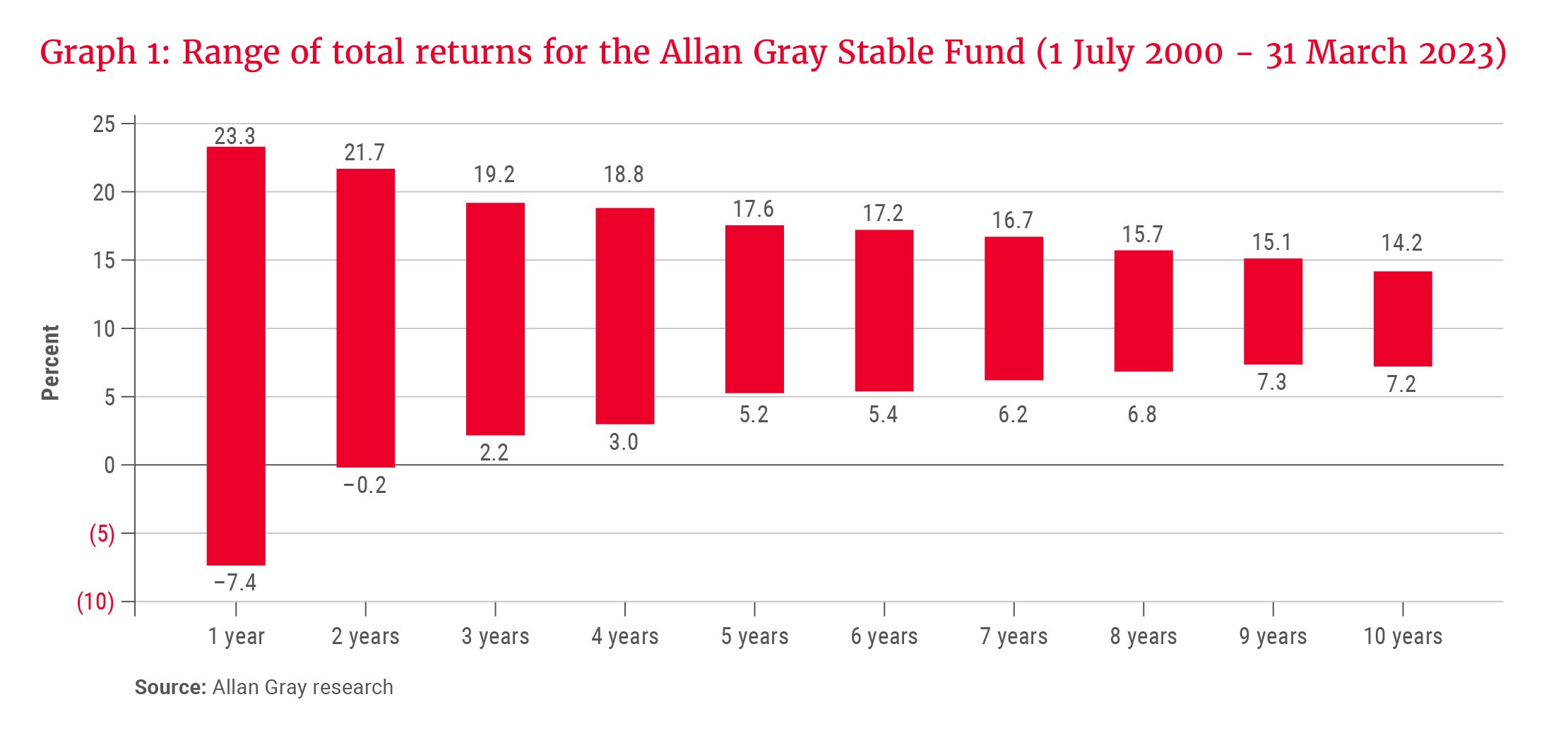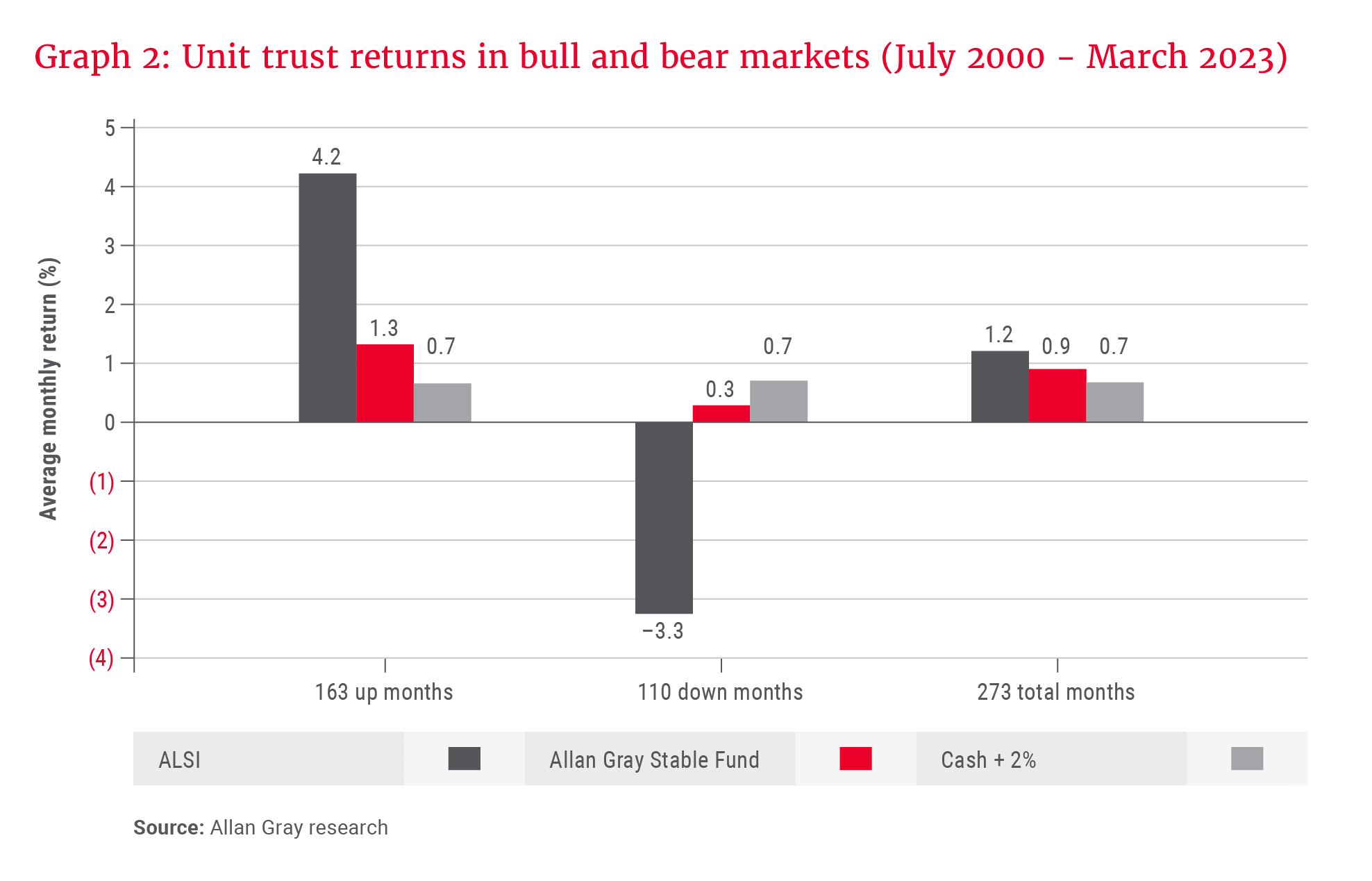In recent years, we have witnessed investors on our platform moving their assets away from low-equity funds to funds that have little to no equity exposure (de-risking), and with that, the relevance of low-equity funds, like the Allan Gray Stable Fund, has been tested. Martine Damonse discusses why investors would be remiss to overlook the Allan Gray Stable Fund.
Conventional wisdom suggests that to achieve a better return, one should be willing to take on more risk. But looking at returns across asset classes over the five years to end-December 2022, this theory has been tested – a story best told by the FTSE/JSE All Share (ALSI)’s lacklustre returns of 8.0% per year compared to the FTSE/JSE All Bond Index’s of 7.8% over the period, but taking investors on a much bumpier ride. Considering the volatility and lack of obvious reward, it is not surprising that some conservative investors have sought perceived safety and steered away from equity markets to assets with smoother return profiles.
While equity markets are volatile and can underperform cash and bonds over shorter periods, over the long term, investors have been compensated for this volatility with substantially higher returns. A look at very long-term data reveals that from 1900 to 31 December 2022, South African equities have delivered on average 9.1% above inflation per year, whereas cash has only delivered 1.1% and bonds 2.3%. This suggests that, over the long term, and especially with higher inflation rates, equities play an important role in any multi-asset class portfolio – including those of risk-averse investors who seek long-term real growth, but also need to protect the purchasing power of their investment.
But how much equity exposure is enough, and how can investors balance the risk-return aspect of their portfolios? A low-equity unit trust can offer a solution.
The Allan Gray Stable Fund created a new category
Our Stable Fund was launched in July 2000 during a period of heightened equity market uncertainty. Investors had only just stopped reeling from the 1998 crash and were in the midst of what would later become known as the tech bubble. South Africans were battling with the decision of whether to take their money offshore, given the political uncertainty and high interest rates, while local equities were deeply out of favour. Similar to today, conservative investors were fearful of investing in equities.
We conduct rigorous research, actively choose the shares we want to own, and patiently wait for the market to realise the shares’ potential.
Against this backdrop, we identified the need for a fund that would offer limited exposure to equities with reduced risk of loss (versus balanced and equity funds), while aiming to deliver superior returns to cash. The Allan Gray Stable Fund was therefore the first of its kind – a low-equity multi-asset class fund for investors seeking to preserve capital and/or wanting a reasonable income, while at the same time looking to grow their investment in real terms.
How the Fund meets its objectives
At launch, the Stable Fund had two equally important objectives, which remain in place today:
- To provide inflation-beating returns
- To protect capital over a two-year period
The Fund achieves its objectives by actively managing asset allocation from the bottom up and carefully considering equity exposure while providing conscious protection against a falling market. We go into more detail on these below.
Actively managing asset allocation
The Fund’s allocation to equities, offshore and fixed income is managed from the bottom up. This means that we compare the expected return on each share we choose with the expected returns on cash and other assets and then weigh up whether the expected return is worth taking on the extra risk to own it.
We have the flexibility to have little to no equities in the Fund in times when we believe that equities are expensive or when other asset classes are trading on more attractive valuations, but we also have the flexibility to increase our net equities to the maximum of 40%, should we find equities attractive relative to other asset classes.
The Fund is managed to comply with Regulation 28 of the Pension Funds Act, which restricts exposure to certain asset classes and securities, including offshore exposure. The recent increase in the offshore investment limit allows us to increase offshore exposure up to 45%. While the increased offshore flexibility gives us more levers to pull, we are mindful of the additional volatility offshore exposure brings, including the risk of exchange rate fluctuations.
Carefully considering equity exposure
As active investors, we don’t invest passively in the index – we choose individual equities for the Stable Fund using the same investment philosophy as for our Equity and Balanced funds. We conduct rigorous research, actively choose the shares we want to own, and patiently wait for the market to realise the shares’ potential.
We carefully select securities that we believe can outperform inflation meaningfully over the long term.
However, we have a slightly different investment process in managing the Stable Fund: We are more cognisant of downside risk when choosing the underlying shares. We can therefore choose to have a lower weighting to individual shares (versus the Balanced Fund) that we believe are too risky – i.e. have a wider range of potential outcomes – and a higher weighting to shares we believe have a higher certainty of outcome, some of which may offer a higher dividend-paying potential. We carefully select securities that we believe can outperform inflation meaningfully over the long term.
Adding equities to a portfolio can increase the volatility of a fund, however, we don’t view volatility as the only risk to mitigate; for us, the most important risk to avoid is permanent loss of capital incurred by overpaying for an asset.
Providing conscious protection against a falling market
The Stable Fund will be the first among our equity-exposed flagship funds to show any sign of caution towards the stock market becoming expensive. We can employ equity market hedging (a form of insurance) to protect against the risk of markets falling, while maintaining exposure to our selection of shares, which we would expect to outperform the market in such conditions.
The large weighting towards fixed income (cash and bonds) is a key component of the Stable Fund, as it helps us achieve appropriate diversification and assists in managing volatility. However, it is not without risk; our portfolio managers pay careful attention to the risks attached to the fixed interest instruments, including credit risk (the willingness and ability to repay interest and capital in full and on time), liquidity risk (the risk of having to sell quickly at a lower-than-expected price), duration risk (sensitivity to interest rate changes) and valuation risk (the risk of overpaying for an asset).
The Fund’s fixed income is also conservatively managed to protect the Fund against the negative effect that interest rate shocks can have on bonds. Given the percentage allocation to interest-bearing securities, the Fund also produces a reasonable level of income.
As stated earlier, the Stable Fund aims to protect capital over a two-year period. If the Fund fails to deliver on this objective, Allan Gray will charge zero investment management fees.
Performance review
Our Stable Fund has protected capital and outperformed inflation meaningfully since inception, delivering 11.2% versus inflation at 5.5% (as at 31 March 2023). Graph 1 illustrates the range of absolute annualised returns achieved over different rolling periods (shifted monthly). It is clear that, over the short term, there is more variability in the returns, with the best-performing result for the Fund over any one-year period being 23.3%, and the worst, -7.4%. However, as you extend your time horizon in the Fund, the range of return outcomes narrows significantly.

Typically, the Fund has been able to protect investors in falling equity markets while outperforming its cash +2% benchmark in rising equity markets, as shown in Graph 2. Looking at the average of the down months (when the ALSI delivered a negative return) since inception of the Fund (110 months to 31 March 2023), the ALSI had an average monthly return of -3.3%, while the Stable Fund still managed to protect capital and produce a positive average monthly return of 0.3%. During the up months, the Fund was able to return 1.3% on average compared to its benchmark, which returned 0.7% on average.
The ability to invest across asset classes … provides us with the necessary flexibility to both generate real returns and focus on capital preservation.
The Fund experienced its first and only negative two-year period (-0.2%) in 22 years in March 2020 during the COVID-19 crash. While a negative two-year return is disappointing, the nature of the market reaction to the pandemic outbreak was unprecedented, leaving very few places to hide and the market recovered swiftly.

Is the Fund right for your portfolio?
The Stable Fund is appropriate for risk-averse long-term investors who aim to, at the very least, keep up with inflation, but also need some degree of capital protection. Likewise, it is suitable for investors with shorter investment time frames (but longer than two years). The Fund is also appropriate as part of a life-staging portfolio, where investors wish to reduce their equity risk in the last few years before retirement, particularly if they are planning to take a cash lump sum at retirement. It is also an option for retirees or any investor who wants to draw a reasonable and sustainable income from their investment.
With an allocation to equities being key to long-term growth, we believe the Allan Gray Stable Fund remains as relevant now as it has been since its inception. The ability to invest across asset classes, including equities, within predetermined limits, provides us with the necessary flexibility to both generate real returns and focus on capital preservation.